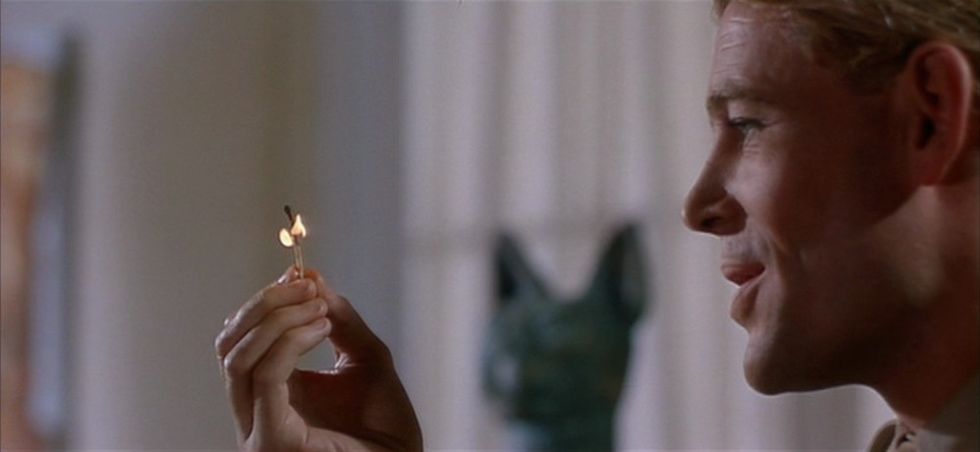How Magical Realist '306 Hollywood' Became the First Doc in Sundance's NEXT Section
Siblings Elan and Jonathan Bogarín take to nonfiction filmmaking to rediscover their deceased grandmother.

A magical realist rumination on the passing of their grandmother, 306 Hollywood was directed by the brother-and-sister team of Elan and Jonathan Bogarín. "We wanted to take the realm of fantasy, imagination, humor, and mythology, and apply them to regular people's lives,” said Jonathan Bogarín to No Film School, "to elevate a normal person's experience into something that feels extraordinary.” Through the course of the film, they do just that, excavating their grandma’s home and reanimating her belongings into a kaleidoscopic treatise on life and death.
The Bogaríns sat down with No Film School at the 2018 Sundance Film Festival to talk about coming up with the imaginative visuals, the visceral side of reality, and why you have to believe in your vision even when the whole world tells you to stop.

NFS: 306 Hollywood features so many fantastical, elaborate scenes. There's a dance sequence, clothes in slow motion, a miniature house...How did you come up with the creative imagery on display in the film?
Elan Bogarín: As we searched for the stories [that would make up this film], much of the film unfolded like an archeological dig. We began with the top layers and literally had layers of junk to go through. We started sifting through everything. Those objects began to tell certain stories, revealing different elements of our grandmother's history, of her past, and also of what we started to get interested in.
Jonathan Bogarín: Other questions also came up of "who gets to write history? Why is [grandma] not in history? Why is someone else in history? How do we write history and place value on certain lives, on certain cultures, on certain time periods, on certain genders? All of these different things that we can identify with that are either part of history or not part of history?” We were interested in finding other people who could draw into that.
For instance, when the funeral director comes, the viewer is open to strange things happening, and so she tells us about the journey of the spirit within the Orthodox Jewish belief. Personally, it was neither my nor Elan's personal belief, but we were like, "wait a minute, this person can come in and be one of our guides. We want her to appear as an apparition in a fairy tale." So we filmed her that way.
"The way we actually live our lives on a day-to-day basis is not necessarily through what’s factual, through what's actually right in front of you."
Jonathan Bogarín: With the dance sequence, we had done the autopsy of Grandma’s dresses with a Clothing Conservator. She talks about how a dress can be alive. We thought, "let's just bring the dresses back to life. We miss our grandmother, we miss that time from the past, and we want to connect with it." And so we brought it to life with music and dance.
Elan Bogarín: The way we actually live our lives on a day-to-day basis is not necessarily through what’s factual, through what's actually right in front of you. Right now, if you have a cold, that's going to impact how you see something. If you had a glass of wine, that's going to certainly impact how you see something. As you go through your daily life, the majority of how you're understanding your reality is through your imagination, through your visceral experience, through how you're emotionally understanding something.
When you lose someone, you are put in a position where the world effectively opens up in a different way because, all of a sudden, you have to search for something that wasn't what we originally thought it was. It's effectively below the seat of reason.
Jonathan Bogarín: It's emotionally raw. Emotions start to flow over you in ways that they wouldn't normally because you can't tune out these powerful emotions.
Elan Bogarín: What we wanted to do was take factual information from the experts, these people who are complete professionals, and then also have the question of, "what did it make you feel?" We wanted to make a film that equally drew you into the emotional, visceral experience and the factual understanding of what you're finding out as you go through the process of losing someone.

NFS: Reality can be such a confusing thing. In this film, you’re dealing with questions of, what is reality? What is memory? The mystery of where we go when we die. At the same time, you're working with video footage of your grandmother over and over again on a timeline. Throughout that process, did you feel closer to the reality of your grandmother? Or did your concept of who your grandmother was change?
Jonathan Bogarín: For me, I felt much closer to the reality. There would be times when we'd be working with the material and I'd be sitting there crying at the computer. And I'm like, "that's how I feel." That was the reality, and [I wanted to see] if I could get someone else to feel it. When we saw people crying at the screening, I'm like, "Oh my god. That's real."
The other thing is the question of growth throughout the process of making this film (because we started filming our grandma in 2001 and it's 2018 now). We've been working on this film [extensively] for about five or six years now. In terms of our transformation as people, incorporating what we learned through the process of not just listening to our grandmother but also excavating all these histories and seeing how she's part of a bigger thing, how we're part of a bigger thing: it has been extremely constructive in the shaping of my reality going forward.
"This film felt, in many ways, like an instruction on how you live."
Elan Bogarín: In effect, it's a film about time. I mean, you have to actually go through the time it takes to make it. When much of what we were dealing with was talking about reflecting on time, of what's past, we unquestionably knew that we were going to go through the same period of time as our grandmother did. This film felt, in many ways, like an instruction on how you live. One of the quotes that always stuck with me from the film is when [Grandma] is discussing whether her life is a success, and she says, "Where does it put me? It puts me into this chair. But I'm alive."
We try so hard to do all of the things we're trying to do, to have the professions we're trying to have, to live whatever grand dreams we have, and then, at the end of the day, you're exactly where you are at that very moment. Having the time to process her extremely simple but very deep philosophy is essential. She's sort of the unwitting philosopher, It's kind of an amazing idea, and it's not any more complex than that.
Nyneve Laura Minnear (Editor): From spending these past two years with [Jonathan and Elan's] exploration, one of the amazing things is that [Grandma's] sitting in that chair and she's gone from the house, and it is what it is. But at the same time, you shape your reality by how you choose to relate to an object, how you choose to even invest your time and energy into looking at something and observing it well. And that shows that reality is figurative. There's not one representation of reality—your emotional experience of something is perhaps mysterious, but it's as real as anything else. You're constantly interacting with it by how you see and observe. So it creates another kind of a universe, and we're world-creating.

NFS: Having just premiered a magical realist documentary at Sundance, what would your advice for other filmmakers who have ambitions to explore something new in the documentary space?
Elan Bogarín: A lot of times you’re made to feel like you're not allowed to tell the story that you want to tell...
Jonathan Bogarín: And in the way you want to tell it.
Elan Bogarín: At a certain point, you need to tell the story you want to tell. The number of times I've realized on every level—in my personal and professional life—that everything was telling me not to do this...well, it began to feel like the world was telling me, "you're not allowed." You have to keep saying, "I am allowed to do this." And you have to believe, honestly believe, that you should do it. Isn't that the only way to make something that someone hopefully hasn't seen before?
Jonathan Bogarín: For anyone who's approaching a subject, I’d say, "really look and think, what is beautiful about that subject? What can you communicate about that subject?" And then find the language to say what you need to say. Don't say, "If I'm making a documentary, I'm just going to do interviews, or I'm just going to shoot verite." Those are wonderful forms, but they're just forms.
You can really do whatever you want. It's remarkable what you can do with a camera. You don't need a huge crew or a huge budget. You need an idea of how your language can express something about the world. The more specific that idea is, the better. Sometimes people will want to take away what's specific [about a project] if something doesn’t fit this or that box. Ultimately, I think what makes it specific is what makes it universal. If you tell me a story that's your story, and it's really your story, I'm going to see something of myself in it as well.
For more, see our ongoing list of coverage of the 2018 Sundance Film Festival.
Header image from 306 Hollywood by Elan Bogarín and Jonathan Bogarín, an official selection of the NEXT program at the 2018 Sundance Film Festival. Courtesy of Sundance Institute | photo by Elan Bogarín and Jonathan Bogarín.













